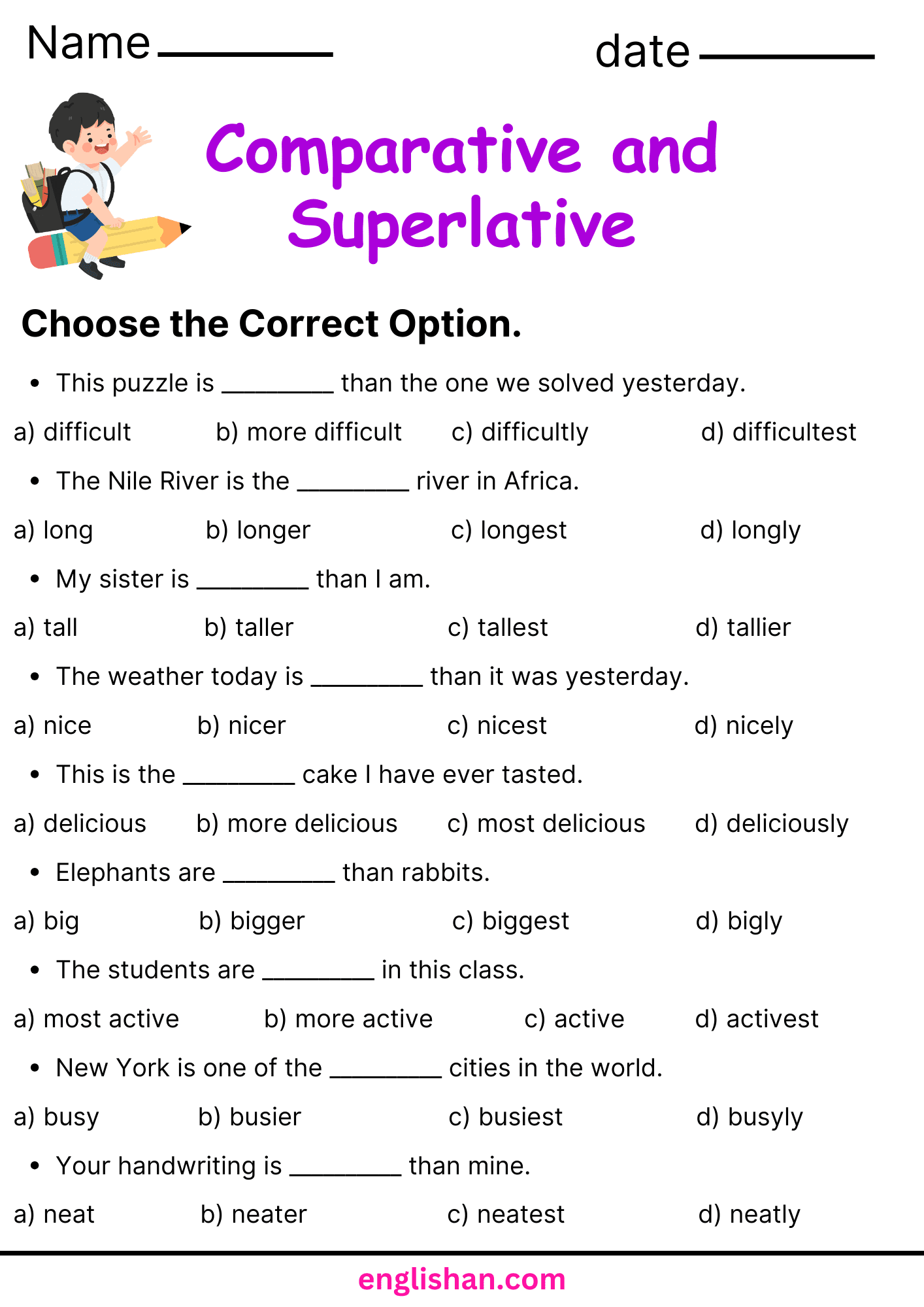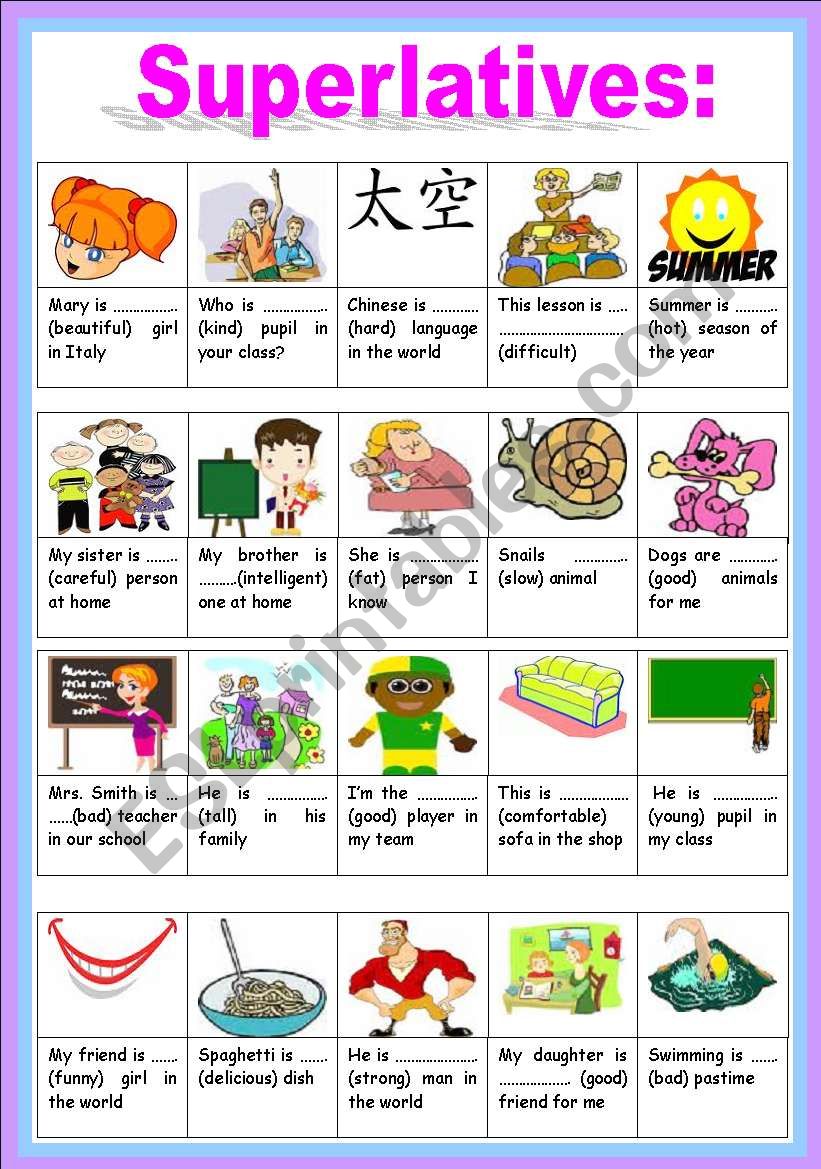
Mastering Precision: The Indispensable Role of a Double Superlatives Worksheet in English Grammar
English grammar, with its myriad rules, exceptions, and nuances, can often feel like a labyrinth to learners. Among the many grammatical constructions that present challenges, the formation and correct usage of superlatives stand out. Superlatives are adjectives or adverbs used to express the highest degree of a quality, indicating "the most" or "the -est" of something within a group. While seemingly straightforward, a common pitfall for both native and non-native speakers is the unintentional creation of what are colloquially, and incorrectly, referred to as "double superlatives." This error, characterized by redundant superlative markers (e.g., "most biggest" instead of "biggest"), highlights a critical need for targeted educational tools. This is precisely where a double superlatives worksheet becomes an indispensable resource, guiding learners away from common errors and towards grammatical precision.
At its core, a superlative form of an adjective or adverb is used when comparing three or more things. For short adjectives (one or two syllables), we typically add the suffix "-est" (e.g., "tall" becomes "tallest," "happy" becomes "happiest"). For longer adjectives (three or more syllables), we precede the adjective with "most" (e.g., "beautiful" becomes "most beautiful," "intelligent" becomes "most intelligent"). There are also irregular forms that must be memorized, such as "good" becoming "best" and "bad" becoming "worst." The error of "double superlatives" arises when a learner incorrectly applies both methods, leading to grammatically redundant and incorrect phrases like "most tallest" or "most best." These constructions are unequivocally incorrect in standard English, as they combine two markers that already convey the highest degree.

The purpose of a double superlatives worksheet is not to teach learners how to form these incorrect structures, but rather to identify, correct, and prevent them. Such a worksheet serves as a crucial diagnostic and practice tool, designed to sharpen a learner’s awareness of superlative formation rules and to reinforce the principle of grammatical efficiency – that is, using only the necessary elements to convey meaning. By presenting sentences that contain these common errors, the worksheet prompts learners to actively engage with the language, analyze the grammatical structure, and apply the correct rules.

Understanding the Error: Why "Double Superlatives" Occur

The tendency to create "double superlatives" often stems from a few common linguistic habits and misunderstandings:

- Over-generalization of Rules: Learners might internalize the rule of adding "most" for longer adjectives and mistakenly apply it universally, even to short adjectives that require "-est."
- Influence of Other Languages: In some languages, a similar construction might be grammatically acceptable, leading to transfer errors when learning English.
- Emphasis for Effect: Sometimes, speakers might use a "double superlative" subconsciously to add extra emphasis, not realizing it’s grammatically incorrect. For instance, "This is the most biggest problem!" might be uttered to convey extreme exasperation, despite its grammatical inaccuracy.
- Lack of Exposure/Reinforcement: Without sufficient exposure to correct forms and targeted practice to correct errors, these mistakes can become ingrained.


A well-crafted double superlatives worksheet directly addresses these underlying reasons. It provides structured opportunities to confront the error, understand why it’s wrong, and internalize the correct forms.
Components of an Effective Double Superlatives Worksheet

To be truly effective, a double superlatives worksheet should incorporate a variety of exercise types to cater to different learning styles and reinforce the concept from multiple angles:
-
Identification Exercises:

- Task: Learners are given sentences, some containing correct superlatives and others containing "double superlatives." They must identify and underline or circle the incorrect ones.
- Benefit: Develops an eagle eye for grammatical errors and strengthens recognition skills.
- Example: "The Everest is the most highest mountain in the world." (Incorrect) vs. "The cheetah is the fastest land animal." (Correct)
-
Correction Exercises:
- Task: Sentences with "double superlatives" are provided, and learners must rewrite them correctly.
- Benefit: Moves beyond mere identification to active correction, solidifying the correct grammatical structure.
- Example: "That was the most worst movie I’ve ever seen." becomes "That was the worst movie I’ve ever seen." or "She is the most prettiest girl in her class." becomes "She is the prettiest girl in her class."
-
Sentence Completion/Fill-in-the-Blanks:
- Task: Learners are given sentences with a blank and a base adjective/adverb, which they must transform into the correct superlative form.
- Benefit: Encourages direct application of superlative rules (adding "-est" or "most") without the explicit presence of the "double superlative" error, thereby preventing its occurrence.
- Example: "Mount Kilimanjaro is the (tall) mountain in Africa." (Answer: tallest) vs. "The Amazon Rainforest is the (diverse) ecosystem on Earth." (Answer: most diverse)
-
Transformation Exercises:
- Task: Learners are given sentences with positive or comparative adjectives/adverbs and asked to rewrite them using the superlative form.
- Benefit: Reinforces the entire spectrum of adjective/adverb degrees and ensures a comprehensive understanding.
- Example: "He is a good runner." (Positive) -> "He is the best runner on the team." (Superlative)
- "This car is faster than that one." (Comparative) -> "This car is the fastest one in the race." (Superlative)
-
Contextual Application/Paragraph Editing:
- Task: A short paragraph or story is provided with several "double superlative" errors embedded within it, along with other correct superlative usages. Learners must find and correct all errors.
- Benefit: Simulates real-world language use, where errors aren’t isolated but appear within a broader context. It also helps learners distinguish between correct and incorrect usage more effectively.
-
Creative Writing Prompts:
- Task: Learners are asked to write short sentences or paragraphs using specific adjectives in their correct superlative forms.
- Benefit: Encourages active production of grammatically correct sentences and promotes fluency.

Crucially, an effective double superlatives worksheet should always come with a clear and accurate answer key. This allows for self-correction, which is a powerful learning mechanism, enabling learners to immediately verify their understanding and pinpoint areas where they still struggle.
Benefits of Incorporating a Double Superlatives Worksheet into Learning
The integration of a targeted double superlatives worksheet offers numerous benefits for learners at various proficiency levels:
- Grammatical Accuracy: Directly tackles a pervasive error, leading to more precise and grammatically sound English.
- Enhanced Clarity: Eliminating redundancy makes sentences clearer and more concise, improving overall communication.
- Increased Confidence: Mastering challenging grammatical points boosts a learner’s self-assurance in speaking and writing English.
- Improved Writing Skills: Accurate superlative usage is fundamental for descriptive and comparative writing, allowing for more sophisticated expression.
- Preparation for Standardized Tests: Many English proficiency exams (TOEFL, IELTS, SAT, ACT) include grammar sections where such errors are frequently tested. Practice with these worksheets can significantly improve performance.
- Development of Critical Thinking: Analyzing sentences for errors requires careful thought and application of rules, fostering analytical skills.
- Efficiency in Language Use: Teaches the principle of economy in language – saying what needs to be said without unnecessary words or structures.
Strategies for Effective Use
For learners, approaching a double superlatives worksheet with a clear strategy can maximize its benefits:
- Review the Rules First: Before attempting the exercises, quickly review the rules for forming superlatives (both regular and irregular).
- Understand the "Why": Don’t just correct; understand why a particular phrase is wrong (e.g., "most biggest" is wrong because "biggest" already means "most big").
- Practice Regularly: Consistency is key. Short, regular practice sessions are more effective than infrequent, long ones.
- Use the Answer Key Wisely: After attempting the exercises, check your answers. If you made a mistake, try to understand why you made it before moving on.
- Speak and Write: Actively try to use correct superlatives in your conversations and writing to reinforce learning beyond the worksheet.
For educators, incorporating a double superlatives worksheet requires thoughtful pedagogical approaches:
- Pre-teach and Explain: Clearly explain what superlatives are and specifically address the "double superlative" error with examples before assigning the worksheet.
- Facilitate Discussion: After students complete the worksheet, discuss common errors as a class. This allows students to learn from each other’s mistakes and deepen their understanding.
- Provide Context: Integrate the worksheet into broader lessons on descriptive language or comparative analysis.
- Vary Activities: Don’t rely solely on worksheets. Combine them with interactive games, speaking activities, and real-world examples from texts.
- Offer Constructive Feedback: Go beyond just marking right or wrong. Explain the reasoning behind corrections and provide tips for improvement.
Conclusion
The journey to mastering English grammar is continuous, marked by persistent effort and targeted practice. While the concept of "double superlatives" might represent a common stumbling block, it also presents a valuable learning opportunity. A meticulously designed double superlatives worksheet is more than just a collection of exercises; it is a critical educational tool that systematically addresses a specific grammatical vulnerability. By providing focused practice in identifying and correcting these redundant constructions, it empowers learners to use superlatives with precision, clarity, and confidence. In an increasingly interconnected world where effective communication is paramount, the ability to express the highest degree of a quality accurately is not merely a matter of grammatical correctness, but a fundamental aspect of eloquent and impactful language use. Embracing the utility of such worksheets is a definite step towards achieving grammatical excellence.
